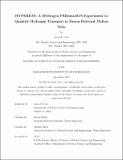HYPERION: A HYdrogen PERmeatION Experiment to Quantify Hydrogen Transport in Fusion-Relevant Molten Salts
Author(s)
Cota, Jaron F.
DownloadThesis PDF (29.14Mb)
Advisor
Short, Michael
Woller, Kevin
Terms of use
Metadata
Show full item recordAbstract
The measurement of hydrogen transport properties of molten salts like FLiBe is crucial for the development of advanced nuclear technologies like lithium-bearing liquid immersion breeding blankets for fusion reactors. Tritium production and the quantification of its mobility in these materials is necessary for efficient operation of these technologies. A common method of measuring these properties is with hydrogen permeation experiments. Hydrogen permeation experiments involve measuring the flux of hydrogen permeating through a substance, and from this flux transport properties like the diffusivity and solubility of hydrogen in the molten salt can be derived with various models of the experimental setup. This thesis describes the process of fabricating and assembling a HYdrogen PERmeatION (HYPERION) experiment and provides preliminary results of the functionality as well as some issues and troubleshooting of the experiment. Using the code Finite Element Simulation of Tritium In Materials (FESTIM), the experiment was also modeled. The models were used to explore the design parameter space of the experiment to determine the experiment’s effectiveness in producing the desired result of accurately calculating the hydrogen transport properties of the molten salt. Through the process of modeling, the assumptions that were normally made when performing these experiments were called into question and their validity was quantified, suggesting that the experiments that have been previously conducted might have been significantly affected by these assumptions. Using these models could eventually improve the accuracy of measured transport properties for molten salts like FLiBe and other nuclear fusion-relevant molten salts and inform the design of hydrogen permeation experiments moving forward.
Date issued
2024-09Department
Massachusetts Institute of Technology. Department of Nuclear Science and EngineeringPublisher
Massachusetts Institute of Technology